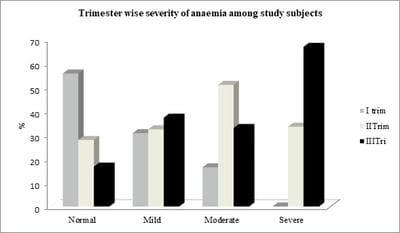Hemoglobin profile of full term pregnant women admitted for delivery in a teaching hospital: a case series study
Soumyashree M N.1, Viveki R.2*
DOI: https://doi.org/10.17511/ijphr.2016.i3.03
1 Soumyashree M N, Postgraduate Student, Department of Community Medicine, Belagavi Institute of Medical Sciences, Belagavi, Karnataka, India.
2* R G Viveki, Professor and Head, Department of Community Medicine, Belagavi Institute of Medical Sciences, Belagavi, Karnataka, India.
Background: Anemia in pregnancy is a common and serious public health problem in developing countries. It is associated with high incidence of premature births, postpartum hemorrhage, puerperal sepsis, etc in mother. Objective: 1) To assess the hemoglobin profile of full term pregnant women admitted for delivery. 2) To analyze the correlation of anemia with obstetrics parameters like gravida, parity, and history of abortions in the past. Methods: The present case series study was conducted among the pregnant women in latent stage of labor admitted in a teaching hospital by using pre- designed, pre- tested, structured schedule. Hemoglobin estimation was done by Shali’s method and anemia was classified according to WHO criteria. Statistical analyses were done by percentages and proportions, Mean and Chi- square test. Results: A high prevalence (88.4%) of anemia (Hb% - < 11.0 gm/dl) was observed among 130 pregnant women at labor. Majority (58.5%) had moderate degree of anemia (Hb%– 7.0 to 10.0 gm/dl) and (04.6%) had severe anemia (Hb% - < 7 gm/dl). The study observed significantly higher prevalence of anemia among those pregnant women who studied upto secondary level (90.3%), and those from below class IV socio- economic status (96%), among those cases less than one year of spacing between previous and index pregnancies (90%). Conclusion: Monitoring the compliance of women with ante- natal care services and strengthening of their health care seeking behavior are important health care measures to be undertaken at the community level.
Keywords: Pregnant women, labor, Anemia, Prevalence, IFA tablets
| Corresponding Author | How to Cite this Article | To Browse |
|---|---|---|
| , Professor and Head, Department of Community Medicine, Belagavi Institute of Medical Sciences, Belagavi, Karnataka, India. Email: |
Soumyashree M N, Viveki R G. Hemoglobin profile of full term pregnant women admitted for delivery in a teaching hospital: a case series study. Public Health Rev Int J Public Health Res. 2016;3(3):102-108. Available From https://publichealth.medresearch.in/index.php/ijphr/article/view/39 |


 ©
© 